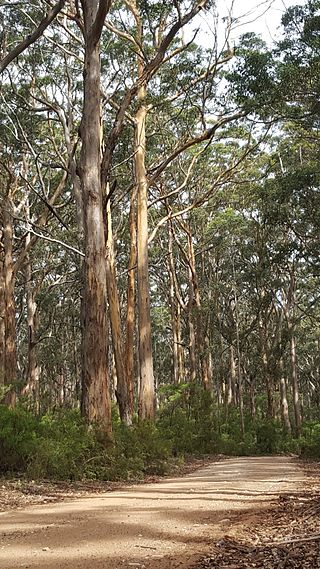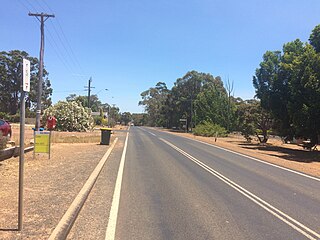Related Research Articles

Eucalyptus marginata, commonly known as jarrah, djarraly in Noongar language and historically as Swan River mahogany, is a plant in the myrtle family, Myrtaceae and is endemic to the south-west of Western Australia. It is a tree with rough, fibrous bark, leaves with a distinct midvein, white flowers and relatively large, more or less spherical fruit. Its hard, dense timber is insect resistant although the tree is susceptible to dieback. The timber has been utilised for cabinet-making, flooring and railway sleepers.

Eucalyptus diversicolor, commonly known as karri, is a species of flowering plant in the family Myrtaceae and is endemic to the south-west of Western Australia. It is a tall tree with smooth light grey to cream-coloured, often mottled bark, lance-shaped adult leaves and barrel-shaped fruit. Found in higher rainfall areas, karri is commercially important for its timber.

Gunns Limited was a major forestry enterprise located in Tasmania, Australia. It had operations in forest management, woodchipping, sawmilling and veneer production. The company was placed into liquidation in March 2013.

Muirs Highway is a Western Australian highway linking Manjimup and Mount Barker, which is on the Albany Highway. It is signed as State Route 102 and is 161 kilometres (100 mi) long. It provides a shorter distance between Manjimup and Albany. It is a lonely highway surrounded with karri and jarrah forests with no settlements in between except the small farming settlement of Rocky Gully.

Manjimup is a town in Western Australia, 307 kilometres (191 mi) south of the state capital, Perth. The town of Manjimup is a regional centre for the largest shire in the South West region of Western Australia. At the 2016 census, Manjimup had a population of 4,349.

South Western Highway is a highway in the South West region of Western Australia connecting Perth's southeast with Walpole. It is a part of the Highway 1 network for most of its length. It is about 406 kilometres (252 mi) long.
Wagerup is a town located in the Peel region of Western Australia just off the South Western Highway. It is located between Waroona and Harvey, 12 km (7.5 mi) south of Waroona.
Northcliffe is a town located in the lower South West region of Western Australia, about 28 kilometres (17 mi) south of the town of Pemberton. It is part of the Shire of Manjimup. At the 2006 census, Northcliffe had a population of 412. Currently, Northcliffe serves a population of around 770 people within the town and surrounding areas. Approximately 31% of the population have post-secondary qualifications.

Great Walk Networking, also known as Great Walk Network, is a bushwalking community in Western Australia. The Great Walk started in 1988 as a protest walk from Denmark to Parliament House in Perth, to raise awareness of logging in Western Australia's old growth forests.
The Conservation Council of Western Australia is the umbrella body for conservation groups and organisations in Western Australia. It has been the co-ordinator, publisher and guiding body for issues of woodchipping in the South West of Western Australia, the logging of old growth forests, as well as providing input into government processes involved with all aspects of environmental protection and conservation.

Warren, also known as Karri Forest Region and the Jarrah-Karri forest and shrublands ecoregion, is a biogeographic region in southern Western Australia. Located in the southwest corner of Western Australia between Cape Naturaliste and Albany, it is bordered to the north and east by the Jarrah Forest region. Its defining characteristic is an extensive tall forest of Eucalyptus diversicolor (karri). This occurs on dissected, hilly ground, with a moderately wet climate. Karri is a valuable timber and much of the karri forest has been logged over, but less than a third has been cleared for agriculture. Recognised as a region under the Interim Biogeographic Regionalisation for Australia (IBRA), and as a terrestrial ecoregion by the World Wide Fund for Nature, it was first defined by Ludwig Diels in 1906.
The Campaign to Save Native Forests (W.A.) (CSNF) was the name of a grassroots organisation which grew from a campaign started in Perth, Western Australia, in 1975, as a response to the development of a woodchipping industry in the south-west jarrah and karri forests of Western Australia. The Manjimup woodchip project aroused significant levels of protest in Perth and the South West region out of public concern that inadequate measures had been made for conservation alongside exploitation of the south west hardwood forests.
The West Australian Forest Alliance is an organization made up of a number of Western Australian environmental activist groups concerned with the destruction of old-growth forests in the South West region. It has published a range of posters and documents. It is a successor to and includes membership of the earlier groups the Campaign to Save Native Forests, South West Forests Defence Foundation, Great Walk Networking, and other member groups of the Conservation Council of Western Australia.

Woodchipping is the act and industry of chipping wood for pulp. Timber is converted to woodchips and sold, primarily, for paper manufacture. In Australia, woodchips are produced by clearcutting or thinning of native forests or plantations. In other parts of the world, forestry practices such as short rotation coppice are the usual methods adopted.
WA Chip & Pulp Company was founded in 1969 to export woodchips from sustainable bluegum plantations after the Government of Western Australia granted a Bunnings led consortium rights to establish a woodchip project in Manjimup. In August 2000, the business was sold to Marubeni.

The Donnelly River is a river in the South West of Western Australia. Its main tributaries are Barlee Brook and Carey Brook. The river runs primarily through state forest reserves, although 25 private landholdings are situated along the length of the river. Clearing of the catchment area is estimated at 20% with the land mostly being used for viticulture, horticulture, dairy, grazing and tourism.
The Warren River is a river in the South West region of Western Australia with a catchment encompassing the towns of Manjimup and Pemberton. The river was named by Governor James Stirling, probably after Admiral Sir John Borlase Warren under whom Stirling served whilst in action in North America in 1813.
Windy Harbour is a holiday settlement surrounded by D’Entrecasteaux National Park. It is located 27 km south of Northcliffe, on the south coast of Western Australia east of Augusta and west of Nornalup. It lies just east of Point D'Entrecasteaux.

The 1976 Bunbury woodchip bombing was an unprecedented and politically motivated act of property destruction that took place at a woodchip export terminal in Bunbury, Western Australia. More than 1000 sticks of gelignite were planted by two environmental protesters with the resulting partial detonation causing an estimated $300,000 in damages. The intention of the bombing was to prevent the export of woodchips from Western Australian old growth forests for 18 months. This act of protest is now largely unknown outside of Western Australia but was considered to have been a serious setback for the emerging environmental movement at the time—despite the perpetrators being unaffiliated with any environmental organisation.
Beth Schultz is an Australian environmentalist. She has campaigned for the preservation of the Karri forests in the south-west of Western Australia since 1975.
References
- ↑ Western Australia. Forests Dept .The Manjimup Woodchip Project. [Como, W.A.] : Forests Dept., 1975.
- ↑ Environment Minister Peter Foss condemns South West Forest Defence Foundation court action against logging near Walpole] in Timberlines (Newsletter of the Bunnings Group of Companies), Jul. 1995, p. 1
- ↑ Lines, William J. (2006) Patriots : defending Australia's natural heritage St. Lucia, Qld. : University of Queensland Press, 2006. ISBN 0-7022-3554-7